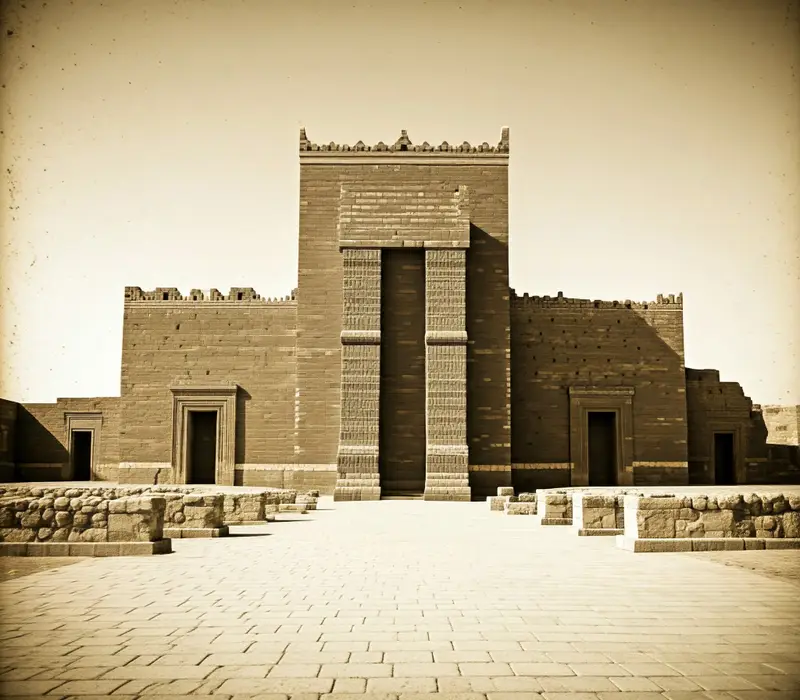Ancient Assyrian City of Kalhu (Nimrud)

Kalhu, also known by names like Kalakh, Calah, and more recently, Nimrud, stands as a testament to the grandeur and strength of the ancient Assyrian Empire. Located around 30 kilometers south of Mosul, Iraq, this city flourished as a center of power and culture during the 9th century BCE. Founded in the 13th century BCE, Kalhu rose to prominence as the capital of the Neo-Assyrian Empire under the rule of King Ashurnasirpal II, who transformed it into a hub of politics, religion, and the arts. Despite its eventual destruction in 612 BCE by the combined forces of the Chaldeans and Medes, Kalhu’s remnants provide invaluable insights into Assyrian civilization.
We will delve into the fascinating history of Kalhu, its architectural wonders, the artifacts discovered in the 19th century, and why it remains an essential destination for anyone interested in Iraq’s ancient heritage.
1. The Founding of Kalhu in the 13th Century BCE
Kalhu was established during the 13th century BCE and initially served as a provincial city in the Assyrian Empire. Positioned strategically near the Tigris River, Kalhu benefitted from fertile lands, ample water resources, and its proximity to major trade routes. Its early development laid the foundation for what would become a major center of Assyrian life.
Assyrian texts refer to the city as “Kalhu,” while in the Hebrew Bible, it is mentioned as “Calah.” The name “Nimrud” was only applied to the site in modern times, likely inspired by the biblical figure Nimrod, who is often associated with hunting, strength, and great cities.
2. Kalhu’s Rise as the Capital of the Neo-Assyrian Empire
Kalhu’s prominence soared in the 9th century BCE when it became the capital of the Neo-Assyrian Empire under King Ashurnasirpal II. Around 879 BCE, Ashurnasirpal II chose Kalhu as his capital and transformed the city into an impressive metropolis. His ambitious construction projects included palaces, temples, city walls, and public buildings that showcased the empire’s wealth and power. The king’s grand vision and architectural prowess were pivotal in establishing Kalhu as the heart of Assyrian political, religious, and cultural life.
Key Highlights of Ashurnasirpal II’s Transformation of Kalhu
The Great Palace: Ashurnasirpal II’s palace, known as the North-West Palace, is one of the most significant archaeological finds in Kalhu. It featured grand halls, throne rooms, and beautifully decorated walls with scenes of royal conquests, religious rituals, and the king’s achievements.
Monumental Gateways and Walls: The city was fortified with massive walls and monumental gateways adorned with large stone carvings and guardian statues, symbolizing Assyria’s might.
Religious Sites: Kalhu housed temples dedicated to important deities such as Ninurta, the god of war, and Nabu, the god of wisdom and writing. These temples attracted worshippers from across the empire.
Kalhu thrived as a political and cultural center under Ashurnasirpal II and his successors, playing a critical role in shaping Assyrian identity and ideology.
3. Art and Iconography in Kalhu
Kalhu’s artistic legacy is particularly significant, with its exquisite alabaster reliefs, colossal statues, and intricate carvings representing the Assyrian Empire’s artistic zenith. The city’s artisans depicted scenes of hunting, warfare, religious ceremonies, and mythology in remarkable detail. These artworks provide a vivid portrayal of Assyrian beliefs, values, and lifestyle, making Kalhu a center for art that set trends throughout Mesopotamia.
Notable Artifacts and Monuments:
Lamassu Statues: The city’s entrances were flanked by massive stone statues known as Lamassu, featuring the body of a bull or lion with the head of a human. These protective deities symbolized strength, intelligence, and protection.
Alabaster Reliefs: Many walls in Ashurnasirpal II’s palace were covered with alabaster reliefs illustrating battle scenes, royal hunts, and religious processions. These reliefs are valuable historical records of the Neo-Assyrian Empire’s daily life and military achievements.
Stelae and Inscribed Stones: Numerous stelae and inscribed stones discovered at the site offer insights into Assyrian laws, decrees, and royal accomplishments.
4. The Destruction of Kalhu in 612 BCE
Despite its status as a flourishing center of the Neo-Assyrian Empire, Kalhu met a tragic end in 612 BCE when it was destroyed by a coalition of Chaldean and Median forces. The city, along with other prominent Assyrian capitals, fell in a campaign aimed at ending Assyrian rule and dismantling its empire.
The fall of Kalhu marked the end of Assyrian dominance in Mesopotamia and the rise of new powers, including the Neo-Babylonian and Median Empires. Although the city’s destruction left it in ruins, its remains offer invaluable insights into the last days of the Assyrian civilization.
5. Rediscovery and Excavation by Austin Henry Layard in 1846
Kalhu’s ancient ruins lay hidden for centuries until they were rediscovered by British archaeologist Austin Henry Layard in 1846. Layard’s excavations revealed a wealth of artifacts, including large stone sculptures, stelae, pottery, and the remnants of Ashurnasirpal II’s palace. Layard’s discoveries brought global attention to Assyrian civilization and played a crucial role in developing modern Assyriology.
Kalhu’s story, from its foundation in the 13th century BCE to its destruction in 612 BCE, encapsulates the heights and challenges of the Assyrian Empire. Rediscovered and brought to the world’s attention by Layard’s 1846 excavation, Kalhu remains a critical site for understanding the history of Mesopotamia and the development of urban civilization. For those visiting Iraq, a journey to Kalhu, or Nimrud, promises an awe-inspiring encounter with one of the ancient world’s most influential empires.